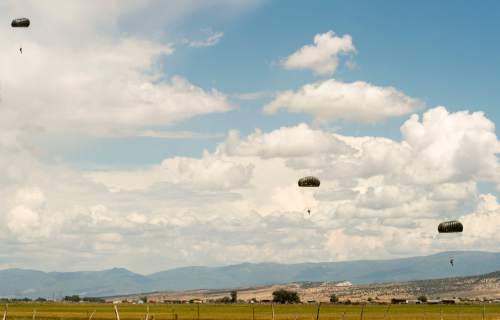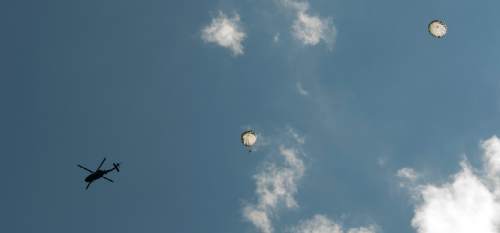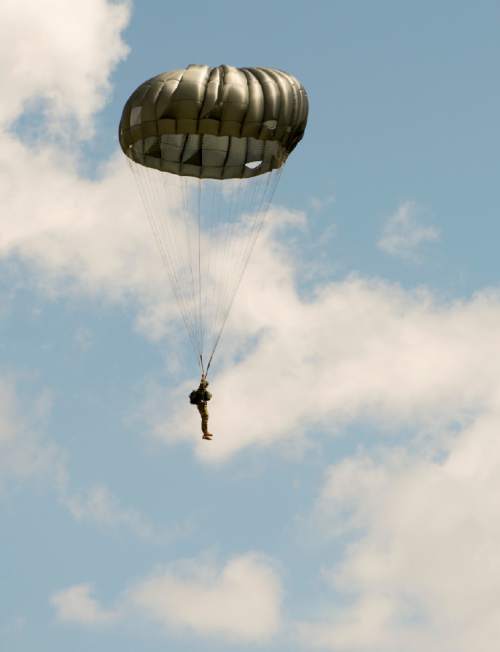This is an archived article that was published on sltrib.com in 2016, and information in the article may be outdated. It is provided only for personal research purposes and may not be reprinted.
One Utah National Guard soldier suffered minor injuries during a Tuesday battle in which Beehive State soldiers were under fire on both the ground and in the air.
A few new details of the battle in city of Marjah in Afghanistan's Helmand province describe a 20-hour fight that has become the most public to involve Utah National Guard soldiers in years. Troops from Utah's Company A, 1st Battalion, 19th Special Forces Group were on the ground.
Fighting was so intense, a helicopter crew that included the Utah National Guard's 1-159th Medevac was fired upon and had to make an early landing.
One soldier from the 19th Special Forces, Staff Sgt. Matthew McClintock, was killed. McClintock belonged to the Washington National Guard.
The 19th Special Forces is assigned to advise the Afghanistan military. The advisers accompany the Afghans on patrols, but they typically fall back when fighting begins.
In a briefing broadcast from the Pentagon on Thursday, Defense Department spokesman Peter Cook said the American and Afghan soldiers were in Marjah on a clearing mission — typically where troops ensure there are no enemy combatants, other threats or obstacles.
The Americans apparently had no choice but to fight this time.
"This was a circumstance in which, as I understand it, they came under fire and this incident took place and Staff Sgt. McClintock lost his life, unfortunately," Cook said.
"They are in harm's way," Cook said of the advisers. "That is clear."
No details of the battle on the ground have been disclosed, though there has been some discussion of what transpired on the helicopters.
Cook, in a Tuesday briefing, said one Pave Hawk helicopter was waved away after taking fire. A second Pave Hawk hit a wall, damaged its rotor and was left on the ground.
Utah National Guard Lt. Col. Steven Fairbourn, a spokesman who on Thursday was at headquarters in Draper, said Utahns were on a third helicopter, as were soldiers from the Wyoming National Guard. That helicopter was able to land and evacuate wounded, Fairbourn said, despite combatants firing at it with small arms and mortar shells.
Fairbourn said the helicopter was damaged and one Utah solider aboard received minor shrapnel wounds. The helicopter left the battlefield, but the damage forced it to land at a nearby base rather than its destination.
The Pentagon has resisted discussing much of the work of the 19th Special Forces Group and other Green Berets advising the Afghans. Fairbourn cautioned against assuming such a battle as Tuesday's was unusual for the Utahns serving in Afghanistan.
"It just becomes more commonly known when there's an injury and certainly when there's a death," he said.
The battle in Marjah has already generated some questions.
Sofrep.com, a blog that covers the special operations forces in the U.S. military, on Wednesday reported that a commander in charge of a quick-reaction force did not allow that force to deploy to support the 19th Special Forces Group after the fight started. The blog, which did not identify its sources of information, said the commander wanted to wait for darkness.
The Washington, D.C., newspaper The Hill reported that Montana Rep. Ryan Zinke, a Republican and former Navy SEAL, wanted a Pentagon briefing on whether the reaction force was delayed and why.
Cook, on Thursday at the Pentagon, said there was "no indication there was any delay whatsoever."
The last Utahn to die in combat was Cody Towse, of Salem, a medic who was posthumously promoted to specialist. He died May 14, 2013. Towse served with the 3rd Battalion, 41st Infantry Regiment, 1st Brigade Combat Team, 1st Armored Division from Fort Bliss, Texas.
Twitter: @natecarlisle











